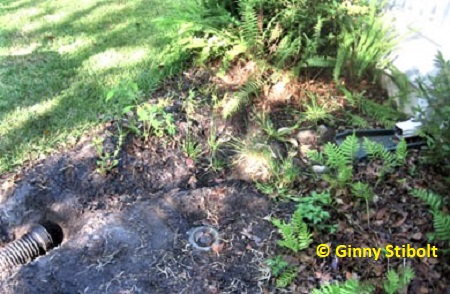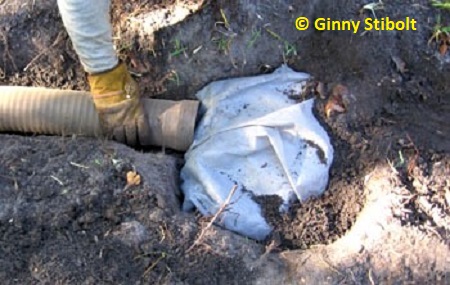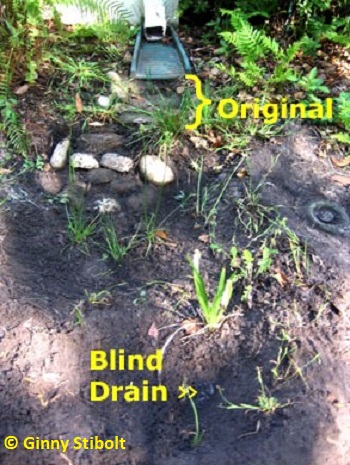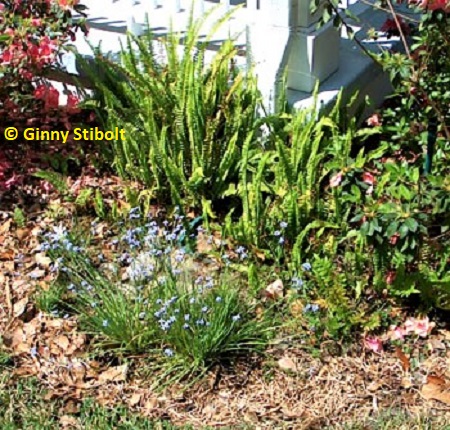Adventures of a Transplanted Gardener |
||||
Expanded rain garden
| ||||
 |
<< The original rain garden is to the right in this photo. We dug out an area that bypassed the sprinkler head (with the green donut at the bottom center of the photo) and planned for the drainpipe so it would have enough slope away from the house for good drainage.
Laying Out the Drainage
Given the site restrictions and the need for a path, my husband and I arranged a ten-foot drainage pipe to lead from a shallow portion of the rain garden opposite the downspout to a sandy area on the other side of the path near the pond. Then we dug the rain garden expansion area so the depths would work with the blind drain. The deeper area just past the original rain garden is about a foot deep and catches a significant amount of water, but when it fills up, the excess water should flow into the blind drain.
 |
Detail of the cloth-covered rocks in the dry well
and the abutting drainage pipe. >>
We dug a hole that is about a fourteen-inch cube. We lined it with a four-foot square of weed barrier cloth, laid the edges out on the sides of the hole, and filled it hole with a wheelbarrow load of clean lava rocks. (We've never bought lava rocks, but have reused the ones left by the previous owner.) We wrapped the cloth around the rocks like a package so the soil will not compromise their ability to collect water. A pantyhose leg covering each end of the drainage pipe will keep the dirt out. We created a similar rock-filled hole at the far end of the pipe making sure that the far end of the pipe was lower in elevation to promote good drainage away from the house. At each end, the pipe butts up against the cloth even with the tops of the holes. At the front end, this means that the water won't flow into the pipe until all the spaces between the rocks are filled to the top. At the far end, water from the pipe dumps into the top of the rock-filled hole.
 |
<< It's about five feet from the original rain garden to the blind drain positioned just under a shallow spot at the far end of the extension. The rocks positioned in the soil below the original garden will prevent erosion as water cascades down that slope.
After we had the drainage in place, we could then finish the rest of the rain garden expansion. The weed barrier cloth was covered with a thin layer of soil and I won't put any deep-rooted or woody plants near this area. In the transition area between the original rain garden and the deeper addition, I set a number of rocks into the soil being careful not to disturb the good stand of blue-eyed grass. The rocks should reduce erosion as water cascades into the deeper section.
I built a berm around the whole garden that's about four inches higher than the top of the blind drain. I also positioned a low point of the berm so extra water would flow out above the sprinkler head and spread into the ferns if the drainage is overwhelmed. I mulched the berm with wood chips-from a tree trimmer working in the neighborhood.
I planted small rushes, cardinal flowers, meadow garlic, rain lilies, and blue-eyed grass in the deeper parts of the garden. Around the edges and across the top of the berm I planted some ladies tresses, walking iris, Stokes aster, and netted chain ferns. I also planted a beautyberry bush just outside the berm. This rain garden is in dappled shade most of the day.
(Update on the cardinal flowers: They did not last here because this garden is not consistently moist. They used to work for my rain gardens in Maryland where there is not a seven-month dry season.)
It's been a couple of months since we finished off this rain garden expansion. The plants have filled in quite nicely, a few rain lilies have bloomed (some white and some yellow), and a volunteer ground cover has spread across the bottom. The garden has been well tested because we received ten inches of rain in July, and with a week left in the month of August, we've already had more than sixteen inches, including eight inches from Fay. The garden does fill up, but the drainage system has been able to handle the volume of water most of the time. At any rate, within an hour or two after the rain stops the standing water is gone, even in this soggy wet season.
When designing a rain garden system, the aim is to have all the water soak into the soil, be absorbed by the rain garden plants, or drain away in three days or less to keep the mosquitoes at bay. Plants in a Florida rain garden need to tolerate both flooding and drought because here in Florida, the rule of rain is there's too much or not enough. So to get ready for the next hurricane or tropical storm and control more stormwater on your property, build a beautiful rain garden.
Ginny Stibolt is a life-long gardener, a botanist, a naturalist, and a garden writer. You may contact her or read more of her articles posted on her website: www.greengardeningmatters.com.
Copyright Ginny Stibolt


